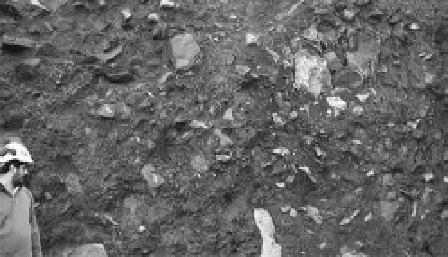Environmental Engineering Reference
In-Depth Information
The pyroclastic formations are coarse, with big
angular blocks, volcanic bombs, lapilli and vol-
canic ash. The lava flows are composed of alkali,
olivine, basanite and hawaiite basalts (aires Barros
quoted by Rosa, 1995).
structures located at the centre of the island, where its
structure is well defined. its most important orienta-
tions are WnW-ese and nW-se.
2
GeoloGical FoRMaTions
1.2.3
Peripherical volcanic complex
(
β
2
)
This volcanic complex dated from the Post-Pliocenic
period extends to the majority of Madeira.
island, namely to Ribeira da Janela, Porto
Moniz, Ponta do Pargo, Ribeira Brava, câmara
de lobos, Funchal, camacha, santa cruz and
santana. it is the volcanic complex occurring in
Madeira's capital city (Funchal), where several
construction's works were made, therefore being
the most well geotechnically characterized.
This complex β
2
is very heterogeneous and con-
sists mainly of alternated and irregular layers of
disaggregated basalts and compact or disaggre-
gated autoclastic disaggregated breccias with vari-
able thickness, interbedded with less significant
compact tuffs.
Most of the geological formations of the island are
constituted by extrusive volcanic rocks. These are
divided into two main groups: the lava rocks and
pyroclastic rocks. The lava rocks are mainly basal-
tic alkalyne type. its origin is effusive and it may
occur more compact or more vacuolar in layers
with variable thickness. The lava rocks are abun-
dant throughout the island.
The pyroclastic rocks are mainly of basaltic
nature originated by explosive volcanic activity.
They are more abundant in the central area of
the island, where the main volcanic structures are
located, usually in a random spatial distribution.
The formations are little compact and present a
breccious aspect.
The base volcanic complex β
1
, the older one, is
represented by different types of pyroclastic mate-
rials, with intercalations of basaltic lava, always
weathered to very weathered. Pyroclastic forma-
tions are coarse, with big angular blocks, volcanic
bombs, lapilli and volcanic ash. sometimes the fine
pyroclastic materials (tuffs with bombs) are domi-
The Post-Miocenic volcanic complex β
2
con-
sists mainly of alternated and irregular layers
of compact basalts and compact and disaggre-
gated autoclastic breccias interbedded with sig-
nificant thickness. in general, the thick basalts
correspond to the most representative geological
formation and concern basaltic rocks, of high
resistance, with gradual variation to vacuolar
basalts, from slightly to very vacuolar and more
or less breccious. They occur generally slightly
weathered or fresh, with moderate to wide frac-
1.2.4
Upper hillsides volcanic complex
(
β
3
)
This Post-Miocenic period complex occur in the
high altitude areas that separate the north region
from the south region of the island, namely in Paúl
da serra, achada da Pinta, lombada das Vacas,
lombada do Meio, cabeços de Fajã dos Vinháti-
cos and Terreiro da luta. These formations are
composed by an alternation of little thick lava flow
and of pyroclastic materials usually yellow-reddish.
The volcanic flows are predominant suggesting
that they were originated from a more effusive
than explosive phase.
1.2.5
Paúl da Serra basaltic complex
(
β
4
)
This superior period basaltic complex occurs in
Paúl da serra, chão dos Balcões, Poiso and ach-
ada do Teixeira. it is constituted mainly by com-
pact basaltic lava flows with some extensive levels
of pyroclastic fine material. it is the result of a
mainly effusive phase from fissure eruptions and
secondary volcanic structures having the lava flows
covered the flattened surfaces.
1.2.6
Recent lava flows
(
β
5
)
This modern period basaltic complex occurs in
Porto Moniz and in the valleys of são Vicente and
seixal. it corresponds to the last volcanic phase
that occurred on the island and it is aged between
0.2 and 0.5 Ma. These flows occupy valleys previ-
ously excavated by erosion, near the coastline.
1.3
Other volcanic formations
The island is crossed by a dense network of dykes.
although this network presents some inflections in
its main orientation it converges to the major volcanic
Figure 3. β
1
tuffs with bombs.















